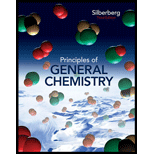
Concept explainers
(a)
Interpretation:Name,atomic symbol and group number of element with
Concept introductionStaircase pattern line is seen in group 13 to 17 of representative elements on the periodic table. It is a hypothetical line that separates the metal and non-metal elements and the elements that touch the staircase type line are generally considered as metalloids.
Elements that are metallic in nature, occupy large lower-left portion of table. Non-metals occupy small upper-right portion of table. Metalloids like along staircase line. Elements that appear in same group have similar behaviour.
(b)
Interpretation:Name,atomic symbol and group number of element with
Concept introduction:Staircase pattern line is seen in group 13 to 17 of representative elements on the periodic table. It is a hypothetical line that separates the metal and non-metal elements and the elements that touch the staircase type line are generally considered as metalloids.
Elements that are metallic in nature, occupy large lower-left portion of table. Non-metals occupy small upper-right portion of table. Metalloids like along staircase line. Elements that appear in same group have similar behaviour.
(c)
Interpretation:Name,atomic symbol and group number of element with
Concept introduction:Staircase pattern line is seen in group 13 to 17 of representative elements on the periodic table. It is a hypothetical line that separates the metal and non-metal elements and the elements that touch the staircase type line are generally considered as metalloids.
Elements that are metallic in nature, occupy large lower-left portion of table. Non-metals occupy small upper-right portion of table. Metalloids like along staircase line. Elements that appear in same group have similar behaviour.
(d)
Interpretation: Name,atomic symbol and group number of element with
Concept introduction:Staircase pattern line is seen in group 13 to 17 of representative elements on the periodic table. It is a hypothetical line that separates the metal and non-metal elements and the elements that touch the staircase type line are generally considered as metalloids.
Elements that are metallic in nature, occupy large lower-left portion of table. Non-metals occupy small upper-right portion of table. Metalloids like along staircase line. Elements that appear in same group have similar behaviour.
(e)
Interpretation: Name,atomic symbol and group number of element with
Concept introductionStaircase pattern line is seen in group 13 to 17 of representative elements on the periodic table. It is a hypothetical line that separates the metal and non-metal elements and the elements that touch the staircase type line are generally considered as metalloids.
Elements that are metallic in nature, occupy large lower-left portion of table. Non-metals occupy small upper-right portion of table. Metalloids like along staircase line. Elements that appear in same group have similar behaviour.
Want to see the full answer?
Check out a sample textbook solution
Chapter 2 Solutions
Principles of General Chemistry
- Draw the complete mechanism for the acid-catalyzed hydration of this alkene. esc 田 Explanation Check 1 888 Q A slock Add/Remove step Q F4 F5 F6 A བྲA F7 $ % 5 @ 4 2 3 & 6 87 Click and drag to start drawing a structure. © 2025 McGraw Hill LLC. All Rights Reserved. Terms of Use | Privacy Ce W E R T Y U S D LL G H IK DD 요 F8 F9 F10 F1 * ( 8 9 0 O P J K L Z X C V B N M H He commandarrow_forwardExplanation Check F1 H₂O H₂ Pd 1) MCPBA 2) H3O+ 1) Hg(OAc)2, H₂O 2) NaBH4 OH CI OH OH OH hydration halohydrin formation addition halogenation hydrogenation inhalation hydrogenation hydration ☐ halohydrin formation addition halogenation formation chelation hydrogenation halohydrin formation substitution hydration halogenation addition Ohalohydrin formation subtraction halogenation addition hydrogenation hydration F2 80 F3 σ F4 F5 F6 1 ! 2 # 3 $ 4 % 05 Q W & Å © 2025 McGraw Hill LLC. All Rights Reserved. F7 F8 ( 6 7 8 9 LU E R T Y U A F9arrow_forwardShow the mechanism steps to obtain the lowerenergy intermediate: *see imagearrow_forward
- Soap is made by the previous reaction *see image. The main difference between one soap and another soap isthe length (number of carbons) of the carboxylic acid. However, if a soap irritates your skin, they mostlikely used too much lye.Detergents have the same chemical structure as soaps except for the functional group. Detergentshave sulfate (R-SO4H) and phosphate (R-PO4H2) functional groups. Draw the above carboxylic acidcarbon chain but as the two variants of detergents. *see imagearrow_forwardWhat are the reactions or reagents used? *see imagearrow_forwardWhat are the reactions or reagents used? *see imagearrow_forward
- Provide the mechanism for this transformation: *see imagearrow_forwardAssign all the signals individually (please assign the red, green and blue)arrow_forwardThe two pKa values of oxalic acid are 1.25 and 3.81. Why are they not the same value? Show the protontransfer as part of your explanation. *see imagearrow_forward
 Introduction to General, Organic and BiochemistryChemistryISBN:9781285869759Author:Frederick A. Bettelheim, William H. Brown, Mary K. Campbell, Shawn O. Farrell, Omar TorresPublisher:Cengage Learning
Introduction to General, Organic and BiochemistryChemistryISBN:9781285869759Author:Frederick A. Bettelheim, William H. Brown, Mary K. Campbell, Shawn O. Farrell, Omar TorresPublisher:Cengage Learning Chemistry & Chemical ReactivityChemistryISBN:9781133949640Author:John C. Kotz, Paul M. Treichel, John Townsend, David TreichelPublisher:Cengage Learning
Chemistry & Chemical ReactivityChemistryISBN:9781133949640Author:John C. Kotz, Paul M. Treichel, John Townsend, David TreichelPublisher:Cengage Learning Chemistry & Chemical ReactivityChemistryISBN:9781337399074Author:John C. Kotz, Paul M. Treichel, John Townsend, David TreichelPublisher:Cengage Learning
Chemistry & Chemical ReactivityChemistryISBN:9781337399074Author:John C. Kotz, Paul M. Treichel, John Townsend, David TreichelPublisher:Cengage Learning Chemistry: Principles and ReactionsChemistryISBN:9781305079373Author:William L. Masterton, Cecile N. HurleyPublisher:Cengage Learning
Chemistry: Principles and ReactionsChemistryISBN:9781305079373Author:William L. Masterton, Cecile N. HurleyPublisher:Cengage Learning Chemistry for Engineering StudentsChemistryISBN:9781337398909Author:Lawrence S. Brown, Tom HolmePublisher:Cengage Learning
Chemistry for Engineering StudentsChemistryISBN:9781337398909Author:Lawrence S. Brown, Tom HolmePublisher:Cengage Learning General Chemistry - Standalone book (MindTap Cour...ChemistryISBN:9781305580343Author:Steven D. Gammon, Ebbing, Darrell Ebbing, Steven D., Darrell; Gammon, Darrell Ebbing; Steven D. Gammon, Darrell D.; Gammon, Ebbing; Steven D. Gammon; DarrellPublisher:Cengage Learning
General Chemistry - Standalone book (MindTap Cour...ChemistryISBN:9781305580343Author:Steven D. Gammon, Ebbing, Darrell Ebbing, Steven D., Darrell; Gammon, Darrell Ebbing; Steven D. Gammon, Darrell D.; Gammon, Ebbing; Steven D. Gammon; DarrellPublisher:Cengage Learning





